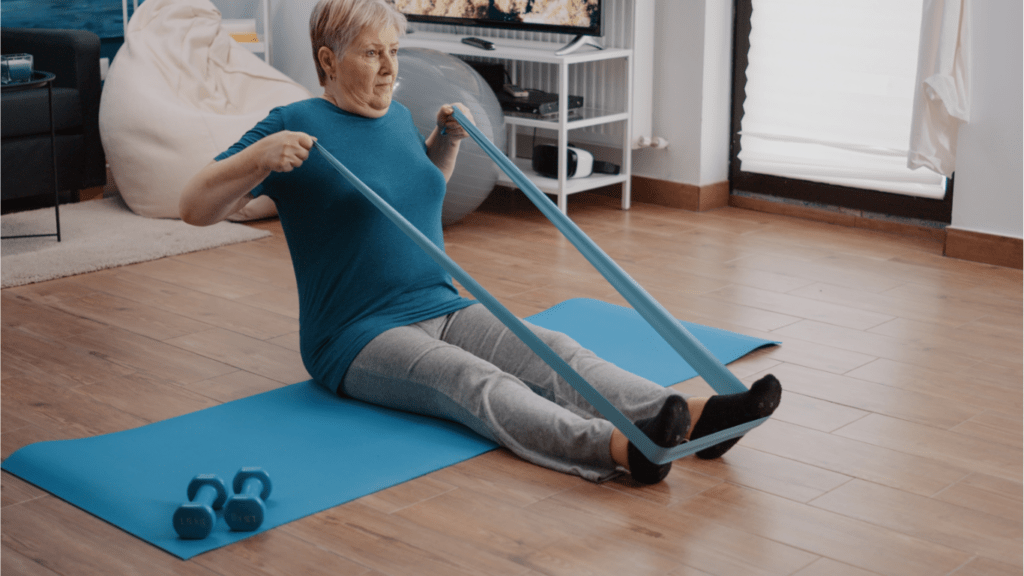Why Use Resistance Bands for Strength Training
Resistance bands offer distinct advantages in strength training. Their versatility enables dynamic workouts tailored to various fitness goals. By applying constant tension, they effectively engage muscles during exercises. This unique resistance can enhance muscle activation compared to traditional weights.
Portability is another highlight. Since resistance bands are lightweight, they fit easily into any bag. This makes them ideal for workouts at home, the gym, or while traveling. I find them particularly useful for maintaining consistency in my routine when away from regular training environments.
The adaptability of resistance bands accommodates all fitness levels. Beginners can start with lower resistance and gradually increase it as they build strength. Advanced users can integrate bands into complex movements to increase intensity. Resistance bands thus serve as a scalable solution, growing with one’s fitness journey.
In strength training, targeting specific muscle groups is essential. Resistance bands excel at isolating muscles that are hard to reach with free weights. Exercises for shoulders, glutes, and legs become more effective with bands. They align well with the natural strength curve of muscles, complementing traditional workouts.
Key Features to Consider
When selecting resistance bands for strength training, it’s crucial to evaluate key features to ensure they meet your workout requirements effectively.
Material and Durability
Material significantly affects the longevity of resistance bands. I’ve noticed that high-quality latex is durable, providing the flexibility needed for various exercises. Fabric bands, while less stretchy, offer non-slip properties ideal for targeted muscle work. Consistent use requires assessing the blend of materials to avoid breakage and maintain tension.
Resistance Levels
Resistance levels determine the effectiveness and intensity of workouts. Bands typically range from light to extra heavy resistance. It’s essential for me to choose bands that match my current fitness level and allow room to progress. Varied resistance ensures adaptability for different exercises like squats or curls.
Portability and Storage
The compact nature of resistance bands supports easy transport and storage. I prefer storing them in small pouches or bags, which keeps them organized during travel. Evaluating size helps in determining whether bands can fit into personal gym bags for use anytime, anywhere without taking up much space.
Accessories and Extras
Additional accessories can enhance the functionality of resistance bands. Some sets include door anchors and handles, which expand exercise options. I appreciate when bands come with a user guide or instructional videos, offering insights into innovative workout routines and ensuring I maximize the bands’ potential.
Our Top Picks for Best Resistance Bands

Choosing the right resistance band is essential for enhancing strength training sessions. Below are my recommendations for beginners, versatile options, and advanced users.
Top Pick for Beginners
When starting a fitness journey, flexibility and ease of use matter. I’ve found the Fit Simplify Resistance Bands Set perfect for beginners. These bands offer varying resistance levels from light to heavy, helping individuals gradually build strength. Each band is color-coded, making it easy to identify the right level. The set includes an instructional guide and access to online workouts for guidance. Made from natural latex, these bands ensure durability and form a staple in any beginner’s fitness routine.
Best Versatile Option
For those seeking versatility, the Tribe Resistance Bands Set offers a comprehensive solution. With five color-coded bands, it covers resistance from 5 to 35 pounds. This set also includes a variety of attachments such as:
- door anchor
- handles
- ankle strap
that allow for diverse workouts targeting all muscle groups. The bands’ quality design features high-grade natural latex ensuring stretchability and strength. Its adaptability makes it a fantastic option for adapting to any strength training regimen.
Best for Advanced Users
Advanced users require bands that withstand intense sessions. The Bodylastics Resistance Bands Set meets this demand. Offering a range up to 202 pounds when combined, these bands provide robust resistance for complex exercises. Its anti-snap technology ensures user safety, integrating woven cord within the bands to prevent over-stretching. The set includes additional accessories such as door anchors and padded handles, enhancing training possibilities and catering to the high-performance expectations of advanced athletes.
How to Incorporate Resistance Bands into Your Routine
Adding resistance bands to a routine enhances strength training. Versatile bands allow the targeting of all major muscle groups. When incorporating them, consistency is vital for progress. Start with a focused approach, gradually increasing complexity as strength builds.
1. Warm-Up Enhancement
Use bands for dynamic warm-ups to increase flexibility and muscle activation. Anchor a band to a stable point and perform shoulder rotations or lateral leg raises. This improves joint mobility and primes the body for more intense exercises.
2. Core Strengthening
Bands provide effective core workouts by adding resistance to exercises like Russian twists or seated abductions. Loop a band around feet for added resistance during sit-ups. This strengthens core muscles and improves overall stability.
3. Upper Body Workouts
Incorporate bands into push-ups or tricep extensions to challenge muscles further. Place a band across your back during push-ups, ensuring even resistance. For tricep extensions, stand on a band and grasp handles, extending arms overhead.
4. Lower Body Exercises
Enhance lower body workouts with banded squats or lunges. Wrap a band just above knees and perform squats to engage glutes and thighs more effectively. For lunges, step on one end of the band, holding the other with the same-side hand for added tension.
5. Cool-Down and Recovery
Bands assist in cool-down routines by facilitating stretches. Use a band to deepen hamstring stretches post-workout, improving flexibility and aiding muscle recovery. Anchor a band under feet and pull gently for calf stretches.
Incorporating these methods maximizes the effectiveness of resistance bands in a training routine, providing a comprehensive workout experience.
Tips for Maximizing Your Resistance Band Workouts
Tracking progress helps identify areas for improvement. I recommend keeping a workout journal, noting the exercises, sets, reps, and resistance levels. Adjust the workout as you get stronger to ensure ongoing progress.
Maintaining proper form prevents injuries and maximizes muscle engagement. Focus on executing each movement with control and precision. If you’re unsure of the correct form, utilize instructional videos or consult a fitness professional.
Incorporating variety prevents workout monotony and targets different muscle groups. Alternate between different types of bands, such as loop bands and tube bands, to introduce new challenges and engage muscles in various ways.
Breathing correctly enhances performance and stability during exercises. Inhale during the preparatory phase and exhale during the exertion phase. Proper breathing aids concentration and maximizes effort during challenging movements.
Gradual resistance level increase ensures progression without overwhelming the body. Start with bands that offer manageable resistance and gradually transition to higher levels as your strength improves. Consistent progression is key to building muscle effectively.

 Milla Collings plays a pivotal role at Make Athlete Action, where her expertise in sports nutrition and conditioning has been invaluable in crafting content that resonates with athletes and fitness enthusiasts alike. With a deep understanding of how nutrition impacts performance, Milla has contributed extensively to the platform’s nutrition and conditioning segments, ensuring that athletes receive practical, science-backed advice. Her commitment to excellence has helped elevate Make Athlete Action as a trusted source of knowledge for anyone looking to optimize their diet and achieve their peak performance.
Milla Collings plays a pivotal role at Make Athlete Action, where her expertise in sports nutrition and conditioning has been invaluable in crafting content that resonates with athletes and fitness enthusiasts alike. With a deep understanding of how nutrition impacts performance, Milla has contributed extensively to the platform’s nutrition and conditioning segments, ensuring that athletes receive practical, science-backed advice. Her commitment to excellence has helped elevate Make Athlete Action as a trusted source of knowledge for anyone looking to optimize their diet and achieve their peak performance.